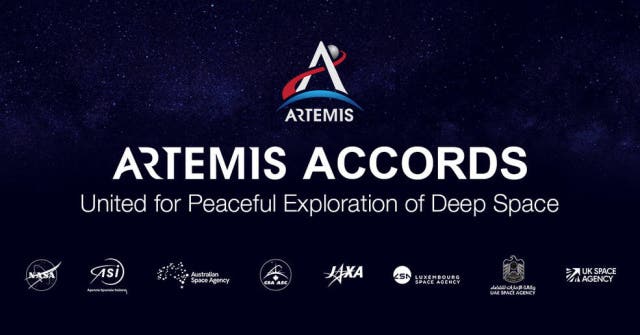Eight nations sign NASA’s Artemis Accords, pledging peace on the moon
The United States and seven additional countries have signed the Artemis Accords, reaffirming their commitment to peaceful, cooperative

[Oct. 14, 2020: Jessica Conditt]
The United States and seven additional countries have signed the Artemis Accords, reaffirming their commitment to peaceful, cooperative and transparent activities on the moon. Yes, that moon. The founding Artemis Accords nations are as follows: Australia, Canada, Italy, Japan, Luxembourg, the United Arab Emirates, the United Kingdom and the United States.
NASA is in the midst of a multi-year program to return to the moon, dubbed Project Artemis, and the signing of the Accords is another step in this process. Project Artemis is NASA’s ambitious plan to get “the first woman and the next man” on the moon in 2024, with the goal of establishing a long-term base for scientific, exploratory and, eventually, commercial purposes. That is, if Congress agrees to fund it.
The Artemis Accords reinforce the 1967 Outer Space Treaty, a non-armament document focused on barring weapons of mass destruction from the moon and other planetary bodies. The ‘67 treaty has been signed and ratified by 110 nations, including Russia, China and the United States.
Countries that sign the Artemis Accords agree to 10 principles, including peaceful exploration, transparency, offering emergency assistance to personnel in distress, publicly releasing scientific information, and safely disposing of space debris. Here’s the full list, as provided by NASA:
Peaceful Exploration: All activities conducted under the Artemis program must be for peaceful purposes
Transparency: Artemis Accords signatories will conduct their activities in a transparent fashion to avoid confusion and conflicts
Interoperability: Nations participating in the Artemis program will strive to support interoperable systems to enhance safety and sustainability
Emergency Assistance: Artemis Accords signatories commit to rendering assistance to personnel in distress
Registration of Space Objects: Any nation participating in Artemis must be a signatory to the Registration Convention or become a signatory with alacrity
Release of Scientific Data: Artemis Accords signatories commit to the public release of scientific information, allowing the whole world to join us on the Artemis journey
Preserving Heritage: Artemis Accords signatories commit to preserving outer space heritage
Space Resources: Extracting and utilizing space resources is key to safe and sustainable exploration and the Artemis Accords signatories affirm that such activities should be conducted in compliance with the Outer Space Treaty
Deconfliction of Activities: The Artemis Accords nations commit to preventing harmful interference and supporting the principle of due regard, as required by the Outer Space Treaty
Orbital Debris: Artemis Accords countries commit to planning for the safe disposal of debris
Notably, Russia — the US’ foil in the Cold War and the original Space Race — and China have not yet signed the Artemis Accords. There’s no word on whether either country is interested, though NASA says more nations will sign in the months and years ahead.
NASA acting associate administrator for international and interagency relations Mike Gold said, “Fundamentally, the Artemis Accords will help to avoid conflict in space and on Earth by strengthening mutual understanding and reducing misperceptions. Transparency, public registration, deconflicting operations — these are the principles that will preserve peace. The Artemis journey is to the Moon, but the destination of the Accords is a peaceful and prosperous future.”
This Brighter Side of News post courtesy of Engadget.
Like these kind of stories? Get The Brighter Side of News' newsletter.



